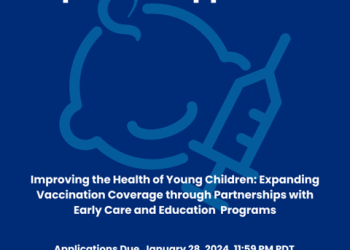Maternal, Child, and Adolescent Health
Local health departments (LHDs) play an important role in coordinating the broader public health system’s efforts to improve the health of women, children and adolescents. NACCHO’s Maternal, Child, and Adolescent Health (MCAH) Program strengthens the capacity of LHDs to effectively ensure and assess the health of women, children and adolescents by providing learning opportunities, developing tools and resources, providing technical support, and facilitating peer exchange.
Latest News
NACCHO’s MCAH/Preparedness portfolio works to increase capacity of LHDs to integrate MCH populations in emergency planning to prepare for future public health threats. Funded through the Centers for Disease Control and Prevention (CDC), this portfolio is a collaboration between NACCHO's MCAH and Preparedness teams.
Supporting Early Care and Education Programs with COVID-19 Mitigation Strategies
Funded through the Centers for Disease Control and Prevention (CDC) – National Center for Emerging and Zoonotic Infectious Diseases (NCEZID) Antibiotic Resistance Coordination and Strategy Unit, the MCAH team’s Pediatric Vaccination portfolio is a collaboration between NACCHO, Child Care Aware of America®, and PennState Extension – Better Kid Care, supporting 50,000 ECE providers and caregivers.
The period from birth until a child’s second birthday is critical for proper development, and for establishing healthy dietary patterns that may influence health throughout the life course. Human milk is the ideal first food as it is uniquely suited for infants’ optimal growth, and it also has a substantial impact on the birthing persons’ health, which makes chest/breastfeeding support critical for improving community health. Exclusive chest/breastfeeding is recommended until 6 months of age, with appropriate introduction of nutrient-dense complementary foods. Many families discontinue chest/breastfeeding prematurely due to many reasons that could be solved with continuity of care in chest/breastfeeding support through the 1,000 days within communities. Moreover, significant chest/breastfeeding and infant/toddler healthy feeding disparities persist by race, ethnicity, socioeconomic status, and geography. The Reducing Breastfeeding Disparities through Continuity of Care project, funded through CDC’s Division of Nutrition, Physical Activity, and Obesity, aims to improve local approaches to chest/breastfeeding protection, promotion, and support through the advancement of continuity of care in optimal infant and toddler feeding.
Through training webinars, ongoing technical assistance, and dissemination of resources, NACCHO shares lessons learned and effective strategies for local-level implementation. For more information about NACCHO’s chest/breastfeeding work, please click here.
NACCHO has recently launched the Continuity of Care in Breastfeeding Support: A Blueprint for Communities, and an online repository of CoC resources. Visit here to learn more.
For more information about this project, please contact [email protected].
In collaboration with the Center for Health and Safety Culture (CHSC) at Montana State University, NACCHO is partnering with local health departments to prevent substance-exposed pregnancies and address fetal alcohol spectrum disorders (FASDs). NACCHO and CHSC are working to develop educational offerings for health department staff to build knowledge and capacity and create tools and resources to integrate substance-exposed pregnancy and FASD prevention into existing efforts. To support these efforts, NACCHO and CHSC are convening the Partners for Substance-Free Pregnancies Network, a group of multidisciplinary partners from local health departments to share resources and learn from each other through peer-to-peer information exchange. Please click here to view the FASD webpage.
For more information about this project or to get involved, please contact [email protected].
Pregnancies, deliveries, postpartum journeys, and navigating the needs of children and families during COVID-19 have been characterized by reduced support during labor and delivery, increased anxiety around birthing and the health of children, and changes in prenatal and postpartum appointments due to efforts to increase physical distancing in offices. In addition, data shows that COVID-19 puts pregnant people at increased risk of severe complications and even death.
To better understand the experience of pregnant and birthing people during the COVID-19 pandemic, NACCHO, in partnership with the What to Expect Project and through funding from CDC’s Division of Reproductive Health, developed three needs assessments for What to Expect consumers. The assessments collected information on how COVID-19 has impacted reproductive health decision-making, parental decision-making, mental health during pregnancy, and pregnancy and birth-related health-seeking behaviors. Additionally, NACCHO conducted listening sessions with local health department (LHD) staff that continued to support the maternal and child health (MCH) population during the pandemic.
The results of the needs assessments and listening sessions demonstrate the need to prioritize MCH populations’ integrations into emergency preparedness planning efforts and to utilize a health equity framework to ensure that historically marginalized communities, communities in rural areas, and low-income communities have access to services amidst a public health threat. Furthermore, it highlights the need for LHDs to strengthen partnerships with community partners such as local clinics, schools, and faith-based organizations to reach the MCH populations during a public health threat, as well as the need to center mental health concerns for this population. As LHDs continue to serve MCH populations, it is vital to support LHDs and the mental health needs of LHD staff to avoid burnout, especially during a public health emergency.
The full report can be accessed here.








